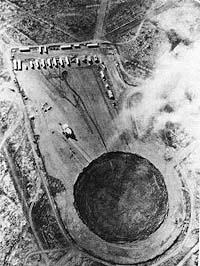
an underground nuclear test crater at Yucca Flats
 an underground nuclear test crater at Yucca Flats |
The United Nations International Atomic Energy Agency estimates that 35 to 40 nations have the knowledge to build an atomic weapon. This is in stark contrast to the five that had such weapons when the Nuclear Non-Proliferation Treaty was negotiated in the late 1960s.
At the request of the Bush Administration, Congress has funded new nuclear weapons design studies and increased preparedness of the Nevada Test Site to resume nuclear testing. It is a pivotal moment for arms control as many countries seek to prevent the proliferation of nuclear weapons.
"Monitoring Nuclear Explosions" is a lecture by Dr. Paul G. Richards--one of the seismologists from Columbia University's Lamont-Doherty Earth Observatory responsible for developing the methods used to distinguish between earthquakes and explosions. Richards also worked for two years in the US Arms Control and Disarmament Agency and as an expert advisor to the Comprehensive Test Ban Treaty negotiations in Geneva.
To date, about 2,000 nuclear weapons tests have been carried out as an intrinsic part of weapons development. In his presentation, Richards discusses the use of seismological methods to detect, identify, locate, and determine the size of underground nuclear explosions. He also discusses the successes and difficulties of taking this objective technical information into a charged political arena where there are deep divides on the issues of arms control.
Seismology provides a key technology in both nuclear arms control and in military intelligence. Global monitoring operations enable us to assess the capability of nuclear weapons deployed by potential adversaries, as well as to detect breaches to the Test Ban Treaty.
Additionally, these same global operations have revolutionized the Earth sciences, enabling detailed studies of plate tectonics, seismic hazards, and the physics of earthquakes.
Dr. Paul G. Richards is the Mellon Professor of the Natural Sciences and a seismologist with the Lamont-Doherty Earth Observatory, a member of the Earth Institute at Columbia University.
Between 1986 and 1990, Richards gave congressional testimony five times on monitoring nuclear explosions. He has devoted much of his life's work to developing and utilizing seismological methods to study nuclear explosions, which have implications in both the scientific and political worlds.
This spring semester, Richards is co-teaching a new undergraduate course at Columbia titled "Weapons of Mass Destruction," a review of the history and environmental consequences of nuclear, chemical, and biological weapons of mass destruction.
Related Links
 Beijing - Dec 08, 2003
Beijing - Dec 08, 2003SPACE.WIRE |